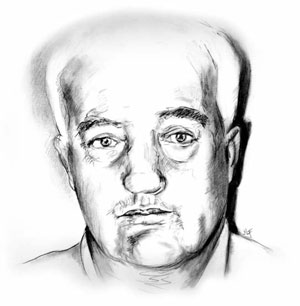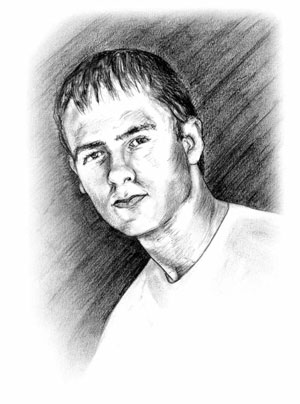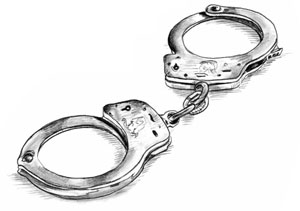Crime Time: Australians Behaving Badly (12 page)
Read Crime Time: Australians Behaving Badly Online
Authors: Sue Bursztynski
Tags: #Children's Books, #Education & Reference, #Law & Crime, #Geography & Cultures, #Explore the World, #Australia & Oceania, #Children's eBooks

JOHN WAYNE GLOVER
THE GRANNY KILLER
I
n 1989, a number of older women were attacked in the expensive Sydney suburb of Mosman. Some survived. Most didn’t.
At first, police thought the killer must be a young man, perhaps even a boy who had issues with his grandmother.
One man, Raymond Roper, was attacked from behind, while he was wearing a long coat and a floppy straw hat. When he turned to defend himself, the attacker, realising he was a man, ran away. Raymond said his attacker was about 30, with blond hair, so police started looking for someone young. Just in case, they also considered teenagers.
That was a mistake.
The first victim, 84-year-old Gwendoline Mitchelhill, was hit on the head outside her home in March 1989. Strangely, her shoes had been taken off and laid neatly by her head.
This became a ‘signature’ of the killer.
The next victim, Lady Winifreda Ashton, 84, died in the bin room of her unit block. Her shoes, hat and handbag had been laid neatly next to her walking stick.
Someone truly sick was at work – but who?

Police continued to check out local schools and watch for a young man.
The next victim, Doris Cox, survived, but couldn’t identify her attacker. She did remember being startled by a young skateboarder. This seemed to support the police’s theory about the killer’s youth.
But the attacker wasn’t young. He was a 58-year-old pie salesman, John Glover, who lived with his wife, two children and in-laws.
John Glover wasn’t young, but he did have issues with older women. His mother, Freda, had left him with his father and taken his younger brother with her. Even before she left, she was not a good influence on him. During World War II, she had made money illegally. She even burned down her own shop for the insurance.
Glover arrived in Australia from Britain in 1956, at first living in Melbourne, occasionally getting into trouble with the law. Then he met and married Sydney woman Gay Rolls. They moved to Sydney. His mother-in-law, Essie, made it clear she didn’t like him.
However he felt about Freda and Essie, he didn’t kill them. Instead, he took his anger out on other older women.
A year before the murders started, he met a woman called Joan Sinclair and they began a romance.
In January 1989, Glover attacked a woman called Margaret Todhunter. She survived and described her attacker. For a long time, no one made a connection between the grey-haired man in a suit and tie she described and the young thug police were hunting. Another survivor, 82-year-old Euphemia Carnie, gave a description a lot like Margaret Todhunter’s.
Now the police began to wonder: could their man be older than they had thought?
In early November, Glover killed two women in as many days, Margaret Pahud and Olive Cleveland. Next, a woman called Muriel Falconer was bashed over the head in her own hallway. This time, Glover left a helpful footprint in the blood around the body.
An old woman he attacked in bed at the Greenwich Hospital pressed an alarm button. A nurse called the police, who suspected him, but hadn’t enough evidence to hold him. They decided to keep an eye on him.
Glover tried to commit suicide. He left a suicide note for his family, saying there would be no more grannies. He survived that suicide attempt. The police found the note, but, for some reason, didn’t do anything with it.
On 19 March, Glover decided to kill Joan Sinclair, then himself. It didn’t occur to the police watching her house that he might be planning to murder his girlfriend. After a few hours, however, they entered Joan’s home. She was dead, bashed over the head. John Glover was in the bath with Scotch and tablets, just about to slip under the water.
He was convicted of six counts of murder and sentenced to life in prison. There were six more murders which police believed he had committed, but they couldn’t be sure.
His family never went to see him and in 1992, his wife said he would be better off dead.
In 2005, John Glover was found dead in his prison cell, where he was thought to have killed himself. He’d finally succeeded in committing suicide.

JULIAN KNIGHT
HODDLE STREET MASSACRE
F
rom an early age, Julian Knight, the Hoddle Street killer, was fascinated by guns and death. A schoolmate later said he brought more than 100 photos of dead bodies to school to show the other students. It was said that he enjoyed describing in detail how bullets had damaged the bodies. Graffiti he had scribbled on his textbooks showed a disturbingly racist attitude.
In January 1987, he started officer training at the Royal Military College, Duntroon, but he didn’t last long. He wasn’t very good at anything except the weapons-based subjects. When he stabbed his sergeant at a Canberra nightclub, he was asked to leave the army for good. His trial for assault and malicious wounding was supposed to take place in June, but was postponed to November.
If he had been tried and jailed in June, perhaps the Hoddle Street tragedy would never have happened, but by November, police had a lot more to worry about than one fight in a nightclub. Julian Knight was back in Melbourne. He had killed seven people and injured nineteen more.
What made him decide to gather all those bullets and guns on the evening of 9 August 1987, and go on a random shooting spree? And why Hoddle Street, anyway? He wasn’t after his enemies. He wasn’t trying to get revenge on anyone. The people he killed didn’t know him. They were just there.

Years later, the policeman who had questioned him right after the crime said that Julian had been happy and excited after the killings. He had bragged about what he had just done. It was fun, for him.
All we know is that he left home at 9.29 p.m. and that a minute later he was shooting at people.
He shot a woman who had got out of her car – six times, till she was dead. Then he shot two people who came to help her. Three more people died in the next few minutes. He kept shooting at anyone passing on the street and then at police. He shot at a police car and then at a police helicopter, forcing it to land. Finally, after a chase through the streets of Melbourne’s suburbs, police managed to catch him in Fitzroy North, just before 10.15 p.m.
At this time, Victorian law didn’t allow a life sentence without parole. Also, Julian was only nineteen. That meant, as a young offender, he had to have a chance to reform. He was sentenced to a minimum of 27 years. He could apply for parole in 2014.
In jail, he was allowed to further his education. The idea was that it would make him a better person when he left. Unfortunately, the education he chose was not one that suggested he was planning to go straight when he left jail. In 2001, he had finished a degree in military strategy and weapons – at taxpayers’ expense!
Over the years, he also went to court many times to complain. He didn’t like being in a high-security prison. He was angry when he got into trouble for having sharp things in his cell and computer disks with information about the prison staff. He considered it an abuse of his human rights when they took away his Ku Klux Klan and Nazi collections.
In 2004, after he had spent about $250,000 worth of taxpayers’ money on his many complaints, he was declared a vexatious litigant – someone who was wasting time and money on silly protests. He was not allowed to take any more legal action in Victoria for ten years, except with special permission.
In 2007, he complained that the prison authorities were interfering with his rehabilitation when they wouldn’t allow him to send a letter of apology to a victim. He wanted to be gradually moved to lowersecurity prisons and have access to programs that would help him after release.
Unless he has changed a lot, it’s unlikely his wish will be granted in the near future.

THE SIGMA BREAK-IN
I
t was like something out of a Hollywood thriller. The team of burglars had been practising for months. They had been checking out various chemical companies in Victoria and South Australia and decided on a Melbourne company called Sigma.
Sigma made drugs to treat such problems as ADD (Attention Deficit Disorder, a behaviour problem suffered mostly by young boys), but the ingredients could be used to make speed, a dangerous street drug that would be worth a fortune to the robbers. George Lipp, Paul Elliott, Brian Zerma and Mark Wills weren’t professional criminals. They just wanted to be rich.

There were two factories in Melbourne’s southeast, one in Clayton, the other in Croydon. They were going to merge and there wasn’t much time for the burglary to be carried out. The burglars broke in 25 times over the nine months before the real thing. During these practice runs, they looked up the company’s records to see what was in the safe. They checked the security systems and found their way around the huge complex. They had $30,000 worth of equipment to help them in their heist.
What they didn’t have was someone who knew how to get into the safe where the containers of drugs were kept.
Lipp remembered a man he used to know in the early 1980s who worked in the security industry. He was an expert on safes. Let’s call him ‘Fred’.
One night in August 1996, Lipp visited the safe expert. First he asked him if he could help open a safe for his mother, who’d lost her key. Fred agreed and went with him. After he’d opened it, Lipp asked him if he could open a much more complicated safe. He showed him a photo of what was obviously not a home safe. He offered him $100,000 to open it.
Fred knew he’d been asked to help with a robbery. To give himself time, he asked for a clearer picture of the safe. Next day, he told Chris Gyngell, the state manager of Chubb Security, what had happened. Gyngell rang the police drug squad.
But they couldn’t just arrest the burglars. They had to catch them in the act. There was an undercover agent, ‘Dave’, who would be able to take over as the safebreaker, but Fred had to introduce him.
Chubb Security gave Dave a crash course in safe-breaking. He would have to convince the burglars that he knew what he was doing.
Fred rang Lipp and pretended to be interested in the robbery. Lipp met him in a pub and discussed the matter. It soon became clear that he wanted the expert to come with them on the night and actually open the safe. Even when he introduced Dave, Lipp wasn’t interested unless Fred also came along.
It was going to be horribly dangerous for the civilian, but it was the only way.
The two undercover men recorded a number of planning sessions, to incriminate the burglars later.
On 15 September, police set up a surveillance team near the factory. They had put secret cameras in the vault room, where the safe was kept.
Now the thriller started to look more like a comedy. The robbers had planned to put their own cameras in the room, because they’d seen a movie about this sort of heist,
Heat
with Robert de Niro, and were copying what the fictional thieves had done. It had to work! When they found the police cameras, instead of running, they were merely annoyed that someone had got in before them.
On the big night, Paul Elliott gave everyone in the team the equipment they needed. He also gave them stopwatches. They didn’t really have any use for the stopwatches, but the characters in
Heat
had them, so they would too.
Lipp and Elliott broke in and disabled the security system. They came out and called the two safecrackers to do their part of the job. It was a wet and miserable night and there were a lot of accidents happening on the slippery roads. The heist took four hours, as they waited for various emergency vehicles to go past. Finally, they came out and the police pounced.
The four men went on trial in October 1998 and pleaded guilty. They all received a number of years in prison, although Elliott’s defence told the court that he’d been trying hard to rehabilitate himself while he was out on bail. He’d got himself a job.
He was working for a security alarm company.

DID YOU KNOW…?
In 1929, Lewis Lasseter, a man who had tried a number of careers and not done too well in any of them, wrote to the member for Kalgoorlie, A.E. Green, telling him that he’d discovered a vast, gold-bearing reef in Central Australia, eighteen years before. He was ignored. Next, Lasseter spoke to John Bailey of the Australian Workers Union. He told Bailey he’d found the reef 33 years before! The Depression was on. The idea of all that gold was tempting. Bailey listened. An expedition set out from Alice Springs in July 1930. They found nothing and most of them turned back. Lasseter kept going and died. It’s thought now that he got the idea from some novels popular at the time. Certainly, he’d never been to Central Australia before. Oddly enough, there are still people who believe in ‘Lasseter’s Reef’.
